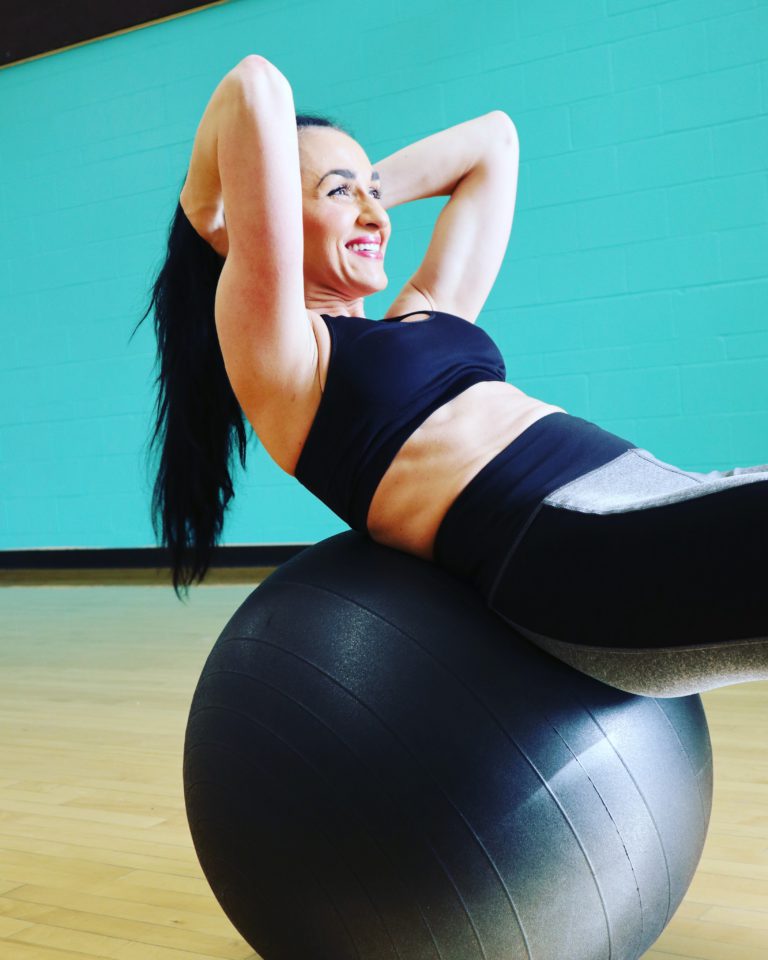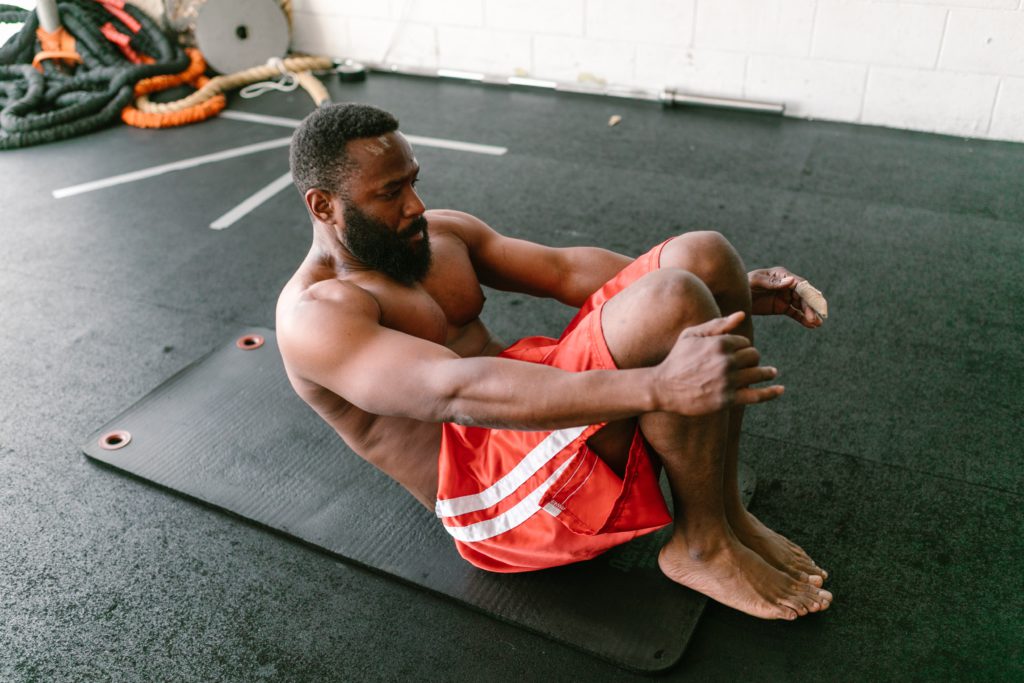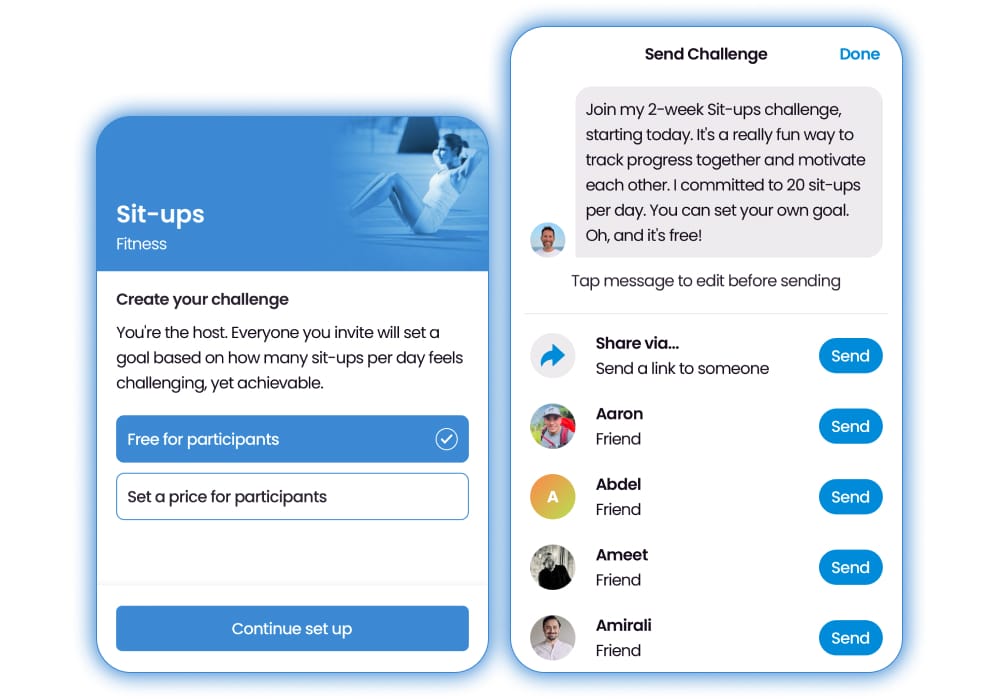
INTRO
What are sit ups?

Sit ups are a popular core exercise great for beginners and experts, and can be modified to meet your needs.
To do a standard sit up, start by lying on your back with your knees bent and your hands behind your head. Lift your upper body off the ground by contracting your abdominal muscles, then lower back down to the starting position.
Sit ups can be modified by using a stability ball or other prop to support your lower back, or by using an inclined or declined surface to increase or decrease the difficulty.
Start a sit up challenge with a friend today and motivate each other to reach your goals.
What do sit ups do?
Sit ups are a convenient exercise that can be done anywhere because they don’t require equipment. They offer a variety of health benefits, including:
Improved core strength
Sit ups work the abdominal muscles, helping to build strength and muscle mass in this area. Strong abdominal muscles can help to improve your overall stability and balance.
Increased calorie burn
Sit ups can be a challenging exercise, and they can help you to burn calories.
Improved posture
Strong abdominal muscles can help to improve your posture, reducing the risk of back pain and other issues.
Enhanced flexibility
Sit ups can help to improve your range of motion and flexibility, particularly in the abdominal and hip areas.
Increased sports performance
Strong abdominal muscles can help to improve your performance in sports and other physical activities.
Enhanced cardiovascular fitness
Sit ups can be part of a high intensity challenge, where they can help to improve your heart and lung function.
How to do sit ups?

This includes keeping your feet flat on the ground and your hands behind your head or ears, and lifting your upper body off the ground by contracting your abdominal muscles.
Intensity. Sit ups can be adjusted to suit different fitness levels by adjusting the number of repetitions, sets, or the speed of the movement.
As you become stronger, you can increase the intensity to continue challenging your muscles.
Progression. As you become stronger and more comfortable with sit ups, you can gradually increase the number of repetitions or sets, or add in additional variations to continue challenging your muscles.
Safety. It is important to use proper form and technique when doing sit ups to reduce the risk of injury. If you have any pre-existing injuries or conditions, you may want to consult with a healthcare professional before starting a sit up routine.
By yourself? See this step-by-step guide on how to do sit ups alone.

Variety. There are many variations of sit ups that you can try to keep things interesting and challenge your muscles in different ways.
Some options include using a stability ball or other prop to support your lower back, or using an inclined or declined surface to increase or decrease the difficulty.
Crunches vs Sit Ups
You can think of crunches like half sit ups. Instead of sitting up, you only raise your body halfway. There are many other ways that you can practice sit ups to challenge different abdominal muscles and keep things interesting. Some options include:
Varying the speed
You can vary the speed of your sit ups to challenge your muscles in different ways. For example, you can try explosive sit ups, where you lift up as fast as possible, or slow and controlled sit ups, where you take your time and focus on form.
Adding variations
There are many variations of sit ups that you can try, such as oblique sit ups, bicycle sit ups, or stability ball sit ups.
Using props
You can use props, such as resistance bands to add additional resistance to your sit ups, or using dumbbells for weighted sit ups.
Changing the angle
You can change the angle of your sit ups by using an incline or decline to challenge your muscles in different ways.
Adding in additional exercises
Varying hand placement
You can vary the position of your hands to target different muscle groups. For example, placing your hands behind your head will target your upper abs, while placing your hands on your temples will target your lower abs.

Starting a Sit up Challenge
Getting started with any new habit can take dedication and discipline, and a sit up challenge is no exception. Here are some tips for building a sit up habit:
1
Start small
Don’t try to do too much too soon. Start with a small number of repetitions and gradually increase as you become stronger and more comfortable.
2
Set specific goals
Having a specific goal, such as being able to do a certain number of sit ups or adding in additional variations, can help to motivate you and keep you on track.
3
Find a buddy
Sit ups can be more enjoyable and motivating when you have someone to workout with. Invite a friend or coworker to join your sit up challenge so you can hold each other accountable and provide support.
4
Incorporate sit ups into your routine
Try to do sit ups at the same time each day or week to make it a regular part of your routine.
5
Stay positive
Don’t get discouraged if you have a tough workout or if you don’t see improvement right away. Building a sit up habit takes time and practice, so be patient and stay positive.
6
Reward yourself
Celebrate your progress and accomplishments, and reward yourself for reaching your goals by doing something you love. This can help to keep you motivated to continue with your sit up challenge.

Build a Sit Up Habit
Start a sit up challenge with your community, clients or friends and have fun getting healthier together.

Start a sit up challenge with your community, clients or friends and have fun getting healthier together.
Sit up Setbacks

Like any new habit, life can get in the way making it harder to stick to your plan. Here are some tips for overcoming common setbacks to starting a sit up routine:
Lack of motivation. If you’re struggling to get motivated to do sit ups, try setting a specific goal or finding a workout buddy to motivate you. You could also try listening to music or a podcast while you workout to make it more enjoyable.
Time constraints. If you’re short on time, try incorporating shorter sit up workouts into your routine or combining your workout with other activities, such as running errands or walking the dog.
Lack of strength. If you’re struggling to do sit ups, try modifying the exercise to suit your fitness level by having a partner hold down your feet or placing your hands at your sides to gently help you sit up. As you become stronger, you can gradually increase the intensity.
Physical limitations. If you have physical limitations or injuries, try modifying the sit ups to suit your needs or consider switching to a lower-impact exercise.
Plateaus. If you feel like you’re not making progress, try increasing the number of repetitions or sets, or adding in additional variations to challenge your muscles.
Overtraining. If you’re feeling tired or burnt out, it may be a sign that you’re overtraining. Try scaling back on your sit up workouts and incorporating more rest and recovery into your routine, like yoga or stretching.
Supporting Your Sit Up Habit
There are many virtual and in-person resources that can help you to create and maintain a sit up habit. Some options include:
Hire a coach or personal trainer. A coach or personal trainer can provide guidance, support, and structured training plans to help you reach your sit up goals.
Use a fitness app. There are many apps available that offer sit up workouts and training plans, as well as support and motivation.
Start or join a sit up challenge. The MasterHealth sit up challenge is a great way to practice your sit ups with friends or family, and you can share tips, and support one another in your sit up journey.
Invite others. Having friends or family members to workout with can make it more enjoyable and help to keep you accountable.

Sit Up Equipment
Various types of equipment can be used to support or enhance your sit up workouts. Some options include:
Exercise mat
An exercise or abdominal mat can provide cushioning and support for your back, making it more comfortable to do sit ups.
Stability ball
A stability ball can be used to support your lower back or to add an element of balance to your sit ups.
Resistance bands
Resistance bands can be used to add resistance to your sit ups, helping to challenge your muscles and improve strength.
Dumbells
Dumbbells can be held in your hands or placed on your chest to add resistance to your sit ups.
Incline or decline board
An incline or decline board can be used to change the angle of your sit ups, making them more or less challenging.
Abdominal roller
An abdominal (ab) roller can be used to add extra resistance and challenge your abdominal muscles during sit ups. This is only advised if you’re at a more advanced level with your sit ups.
Sit-Up FAQ's
Step-by-step: How to do sit ups alone:
- Lie flat on your back on a mat or a comfortable surface, with your knees bent and your feet flat on the ground.
- Place your hands behind your head or cross your arms over your chest.
- Engage your abdominal muscles and lift your upper body off the ground, keeping your neck and spine in a straight line. It can help to imagine that you’re pulling your belly button towards your spine.
- Exhale as you lift your upper body off the ground and inhale as you lower back down in a controlled manner, making sure not to slam your back onto the ground.
- Repeat the movement for your desired number of repetitions.
The number of sit-ups you should do in a day depends on your fitness goals, current fitness level, and overall health. If you’re just starting out with exercise, it’s important to start slowly and gradually increase the number of sit ups you do to avoid injury.
A general recommendation is to aim for 3 sets of 15-20 sit ups per day, gradually increasing the number of sets and reps over time. It’s also important to incorporate a variety of exercises and activities into your fitness routine to promote overall health. And consider adding in squats or lunges to change things up and reduce excess strain.
Sit-ups primarily work the muscles of the core, which includes the rectus abdominis, transverse abdominis, and obliques. The rectus abdominis is the muscle responsible for the “six-pack” look. The transverse abdominis helps to stabilize the core and protect the spine. The obliques are on the sides of the abdomen and are responsible for twisting and rotating movements.
In addition to the core muscles, sit-ups also work the hip flexors, which are a group of muscles located at the front of the hips that help to lift the legs and bend the hips. However, it’s important to note that sit-ups are not the most effective exercise for strengthening the hip flexors and can lead to overuse injuries if performed excessively or improperly.
Any exercise that’s performed incorrectly can lead to unnecessary injury or strain. There are several reasons why you might experience back pain when doing sit-ups, including:
Poor form. If you’re not performing sit-ups with proper form, you may be placing undue stress on your back muscles, which can lead to pain. Common mistakes include pulling on your neck or head, rounding your back, or arching your back too much.
Weak core muscles. If your core muscles are weak, your back muscles may be compensating during the sit up movement, leading to pain and discomfort.
Pre-existing back injury or condition. If you have a pre-existing back injury or condition, such as a herniated disc or sciatica, sit ups may exacerbate your symptoms and cause pain.
Overuse or excessive repetition. Doing too many sit-ups or repeating the exercise too frequently can lead to overuse injuries, including strains and sprains in the back muscles.
If you experience back pain during sit-ups, it’s important to stop the exercise immediately and consult with a healthcare professional or personal trainer. They can help assess your form, identify any underlying issues, and recommend alternative exercises or modifications to help prevent further injury.










